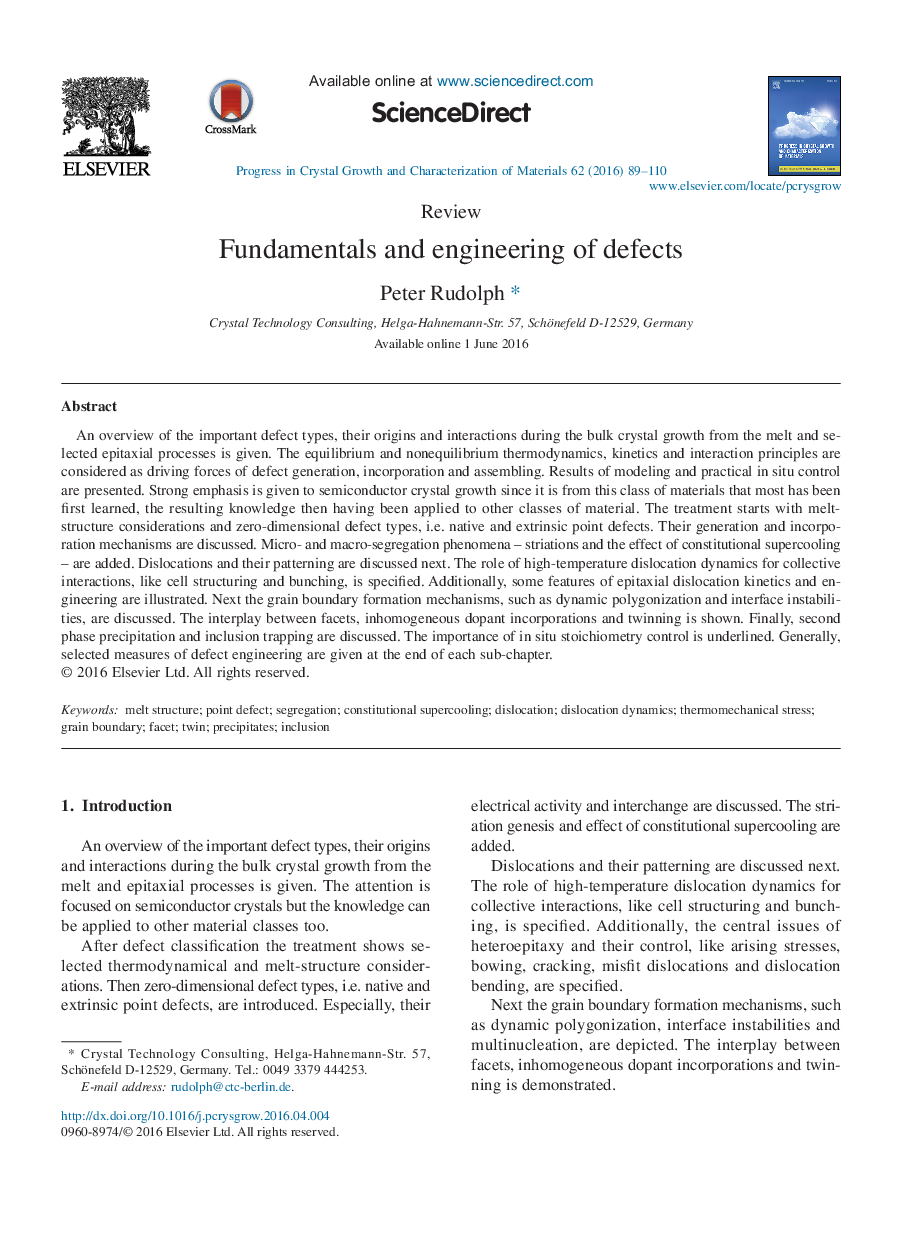| کد مقاله | کد نشریه | سال انتشار | مقاله انگلیسی | نسخه تمام متن |
|---|---|---|---|---|
| 7987696 | 1515414 | 2016 | 22 صفحه PDF | دانلود رایگان |
عنوان انگلیسی مقاله ISI
Fundamentals and engineering of defects
ترجمه فارسی عنوان
مبانی و مهندسی نقص
دانلود مقاله + سفارش ترجمه
دانلود مقاله ISI انگلیسی
رایگان برای ایرانیان
کلمات کلیدی
ساختار ذوب، نقص نقطه، جدایی تعلیق قانون اساسی، جابجایی، پویایی جابجایی، تنش ترمومکانیک، مرز دانه چهره دوقلو، رسوب می کند گنجاندن،
Thermomechanical stress - استرس حرارتیconstitutional supercooling - بازدارندگی قانون اساسیSegregation - جداسازیDislocation - دررفتگیTwin - دوقلوPrecipitates - رسوباتMelt structure - ساختار ذوبgrain boundary - مرز دانهPoint defect - نقص نقطهInclusion - ورودDislocation dynamics - پویایی جابجاییfacet - چهره
ترجمه چکیده
خلاصه ای از انواع نقص مهم، ریشه های آنها و تعاملات در طول رشد کریستال فشرده از ذوب و فرایندهای اپیتاکسالی انتخاب شده است. ترمودینامیک تعادل و عدم توازن، سینتیک و اصول تعامل به عنوان نیروهای محرک تولید، ترکیب و مونتاژ نقص در نظر گرفته می شود. نتایج مدل سازی و کنترل عملی در محل ارائه شده است. تأکید قوی بر رشد بلوری نیمه رسانا است، زیرا از این طبقه از مواد است که اغلب برای اولین بار آموخته شده است، دانش حاصل آن پس از آن به سایر کلاس ها اعمال شده است. درمان با ملاحظات ساختار ذوب و انواع نقص صفر، یعنی نقص های نقطه ای بومی و بیرونی شروع می شود. مکانیسم تولید و سازندگی آنها مورد بحث قرار گرفته است. پدیده های پراکندگی میکرو و کلان - استراتژی ها و تأثیر بازدارندگی قانون اساسی - افزوده می شود. ریزش ها و الگوی آنها در آینده مورد بحث قرار می گیرد. نقش پویایی جابجایی در دمای بالا برای تعاملات جمعی مانند ساختار سلول و دسته بندی مشخص شده است. علاوه بر این، برخی از ویژگی های سینتیک و مهندسی جابجایی اپیتاکسیال نشان داده شده است. بعدا مکانیسم های شکل گیری مرز دانه مانند چند ضلعی پویا و ناپایداری های رابطی مورد بحث قرار می گیرد. اثر متقابل بین جنبه ها، ترکیب دوگانه غیر دوبعدی و دوزندگی نشان داده شده است. در نهایت، مرحله دوم بارش و ضبط شامل بحث و گفتگو است. اهمیت کنترل استوکیومتری در محل یادآوری شده است. به طور کلی، اندازه گیری های انتخاب شده از مهندسی نقص در پایان هر بخش زیر داده می شود.
موضوعات مرتبط
مهندسی و علوم پایه
مهندسی مواد
دانش مواد (عمومی)
چکیده انگلیسی
An overview of the important defect types, their origins and interactions during the bulk crystal growth from the melt and selected epitaxial processes is given. The equilibrium and nonequilibrium thermodynamics, kinetics and interaction principles are considered as driving forces of defect generation, incorporation and assembling. Results of modeling and practical in situ control are presented. Strong emphasis is given to semiconductor crystal growth since it is from this class of materials that most has been first learned, the resulting knowledge then having been applied to other classes of material. The treatment starts with melt-structure considerations and zero-dimensional defect types, i.e. native and extrinsic point defects. Their generation and incorporation mechanisms are discussed. Micro- and macro-segregation phenomena - striations and the effect of constitutional supercooling - are added. Dislocations and their patterning are discussed next. The role of high-temperature dislocation dynamics for collective interactions, like cell structuring and bunching, is specified. Additionally, some features of epitaxial dislocation kinetics and engineering are illustrated. Next the grain boundary formation mechanisms, such as dynamic polygonization and interface instabilities, are discussed. The interplay between facets, inhomogeneous dopant incorporations and twinning is shown. Finally, second phase precipitation and inclusion trapping are discussed. The importance of in situ stoichiometry control is underlined. Generally, selected measures of defect engineering are given at the end of each sub-chapter.
ناشر
Database: Elsevier - ScienceDirect (ساینس دایرکت)
Journal: Progress in Crystal Growth and Characterization of Materials - Volume 62, Issue 2, June 2016, Pages 89-110
Journal: Progress in Crystal Growth and Characterization of Materials - Volume 62, Issue 2, June 2016, Pages 89-110
نویسندگان
Peter Rudolph,
